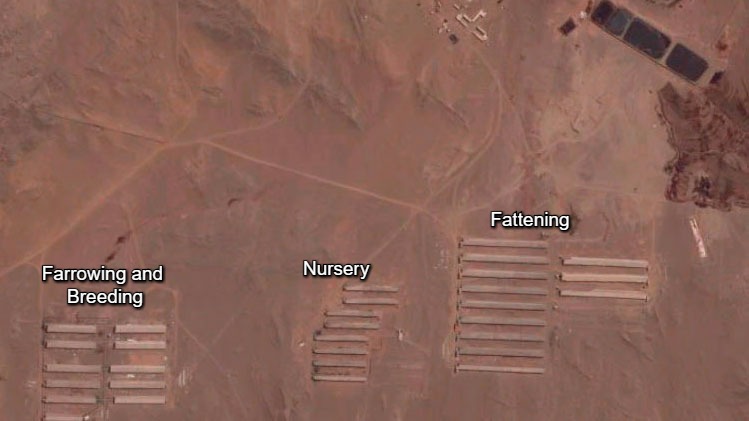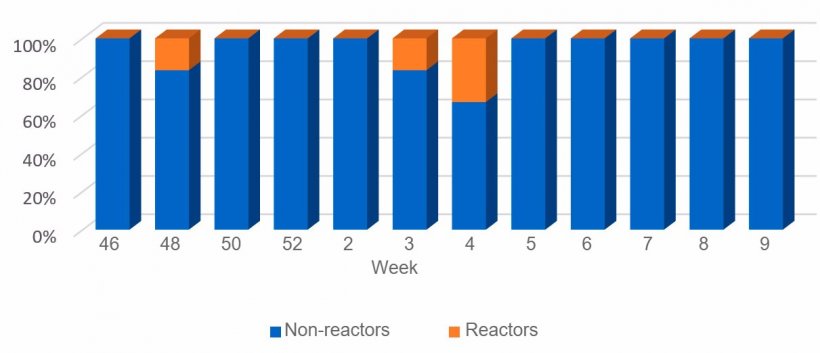Introduction
Porcine epidemic diarrhoea (PED) is an acute and highly contagious enteric disease that can infect pigs of different ages; however, its severity varies and depends on the type of strain, infectious viral load and age of the pig (Song and Park, 2012, Lee, 2015).

In general, the disease is characterized by high morbidity, which can reach 100%, and high mortality in piglets, especially amongst piglets younger than 1 week of age (Huang et al., 2013).
PED was considered an exotic disease in Peru until its confirmation in September 2013, when the National University of San Marcos, together with the National Animal Health and Agri-food Quality Service (SENASA), confirmed the disease by immunochromatography and, later on, duplex real-time PCR, which allowed differentiation from the TGE virus.
To date, several outbreaks of PED have been reported in Peru, their diagnosis based on clinical signs and RT-PCR. In most of these cases, the farm could only been stabilized.
Background
This outbreak occurred in a 4500-sow farm north of Lima, Peru, with a strict biosecurity system (perimeter fencing and drive-through vehicle disinfecting systems) that allowed it to remain free of PRRSv, PEDv, TGEv, PDCov and Mycoplasma hyopneumoniae.

Photo 1 Farm distribution
Diarrhoea and vomiting were observed in lactating piglets (photo 2) in September 2014 (week 38). Four days after the first cases, the percentage of diarrhoea (photo 2) in first-week piglets increased and also affected, combined with vomits, pregnant sows and sows in the farrowing unit, reaching a prevalence of approximately 20%.

Photo 2 Presenting clinical picture.
Pre-weaning mortality reached 29% (Graph 1), resulting in a reudction in the number of weaned piglets per litter (Graph 3).

Graph 1. Percentage of pre-weaning weekly mortality, before and during PED.

Graph 2. Percentage of post-weaning weekly mortality, before and during PED.

Graph 3. Average weaned/female as piglets and kilograms of litter, before and during PED (from week 38).
Diagnosis
A PED-compatible viral picture was suspected and samples of small intestine (jejunum and ileum) were collected and processed in paraffin blocks to be sent to the University of Minnesota for a histopathological study. The lesions were highly correlated with the damage caused by the virus.
Subsequently, faecal material was sent to rule out PEDv by real time PCR, obtaining positive results to the virus, with a CT of 18. The virus was isolated and identified, revealing that the isolated strain was related to the American S-INDEL wild-type strains (Gina Castro, Molecular and phylogenetic characterization of strains detected in Peru).
Intervention
A decision was made to implement a disease eradication program. One of the crucial aspects of the program was to define the strategy to be followed, shown below.
1. Stabilization of the breeding herd:
- Replacement females were introduced at week 40 to allow for 5 months of replacements. After this, the farm didn't introduce any new animals for a period of 5 months.
- At week 41, the breeding herd was homogenized to the PEDv virus via feedback, with the aim of stimulating their immune system and reducing infection and dissemination of the virus. This action determined the "day 1" of the process.
To prepare the feedback as a health tool, the intestines of piglets with a PED active infection (24 hours post-infection) were removed and dissolved in a solution of 500 ml of chlorine-free cold water. A blender was used to homogenize the solution, which was then inoculated orally to the 4500 sows, replacements and boars at a dose of 10 ml each. - From week 41 onwards, the Mc Rebel procedures were applied in the management of piglets and pre-farrowing sows, in order to reduce the spread of the virus.
Management in pregnant sows:
- Admission to clean, disinfected facilities with a down time higher than 7 days.
- Elimination of sow faeces before and during farrowing.
Management in the farrowing unit:
- Strict All-in-All-out.
- Emphasis on colostrum intake from the piglets' own dam
- No cross lactation or nurse sows.
- No movements of piglets.
- On day 7 piglets were tail-docked and given iron dextran and an anticoccidial. After this, all manipulation was restricted in order to avoid the spread of the virus between litters.
Staff movements:
- Reduction of movements of people between the farrowing and gestation areas.
Reinforcement of the external biosecurity program.
2. Disinfection bubble:
In order to create a disinfection bubble in the facilities, early weaning was carried out for 3 consecutive weeks, and the age of pigs transfer to the fattening facilities was reduced, thus increasing the density (0.13m2 / pig). Changes in pig movements were maintained for 6 weeks after day 1. All unoccupied facilities were washed, disinfected and dried for a period of 6 weeks.
After an adequate down time of the facilities had been achieved, weaned piglets were brought in and handled following a strict All-in-All-out system, and each barn was set up as an independent epidemiological unit.

Photo 3 Cleaning and disinfection of facilities.
3. Monitoring
Breeding unit
Monitoring was initiated 6 weeks after stabilization of the breeding unit, focusing on one- and three-week-old piglets. 30 faecal samples were obtained for each analysis,through the use of swabs sent to the Universidad Mayor de San Marcos for diagnosis of PED by RT-PCR. The frequency of analysis was fortnightly and weekly. The farm was considered stable positive, until 4 consecutive negative results with both systems of analysis were achieved.

Graph 4. Outcomes trend in suckling piglets.
Nursery and fattening
The nursery phase was started in the 5th week of 2015 and monitored in each barn at the beginning and end of the nursery period.
Faecal samples were taken to rule out PEDv by RT-PCR.
4. Verification
On week 6 of 2015, prior to start introducing replacement gilts at the breeding site, 30 sentinel pigs less than 70 days old were introduced from a PEDv-negative farm. The exposure of the sentinels lasted one month, and they were constantly monitored by RT-PCR, with negative results, at the National University of San Marcos and the University of Minnesota.
Post-eradication monitoring
program
At the end of the program, samples of oral fluids were obtained from pigs entering the breeding and nursery areas. Oral fluids were obtained with collection ropes, and subsequently extracted from the ropes and impregnated into FTA cards, for shipment to the University of Minnesota, which was responsible for doing a RT-PCR analysis. This monitoring was carried out in all barns and the results were satisfactory. After this, all the production phases were monitored monthly.
The eradication program was consider to be fully completed when the culling of the last sows exposed to the PED outbreak was confirmed.
Conclusions
The key points that allowed us to control and eradicate the PED virus include:
- Speeding up herd stabilization through farm closure, feedback of the population, and fast and strict application of the McRebel protocol principles.
- The disinfection bubble and "all-in-all-out" compliance helped us maintain the negative status of weaned piglets.
- The human team was instrumental in running the program. Teamwork was great, and values such as discipline, integrity and perseverance were key.
The synergism of all these activities led to regaining sanitary status and improving production parameters.
Biosecurity and prevention protocols were strengthened, especially in relation to people, vehicles and tools gaining access to the farm.








